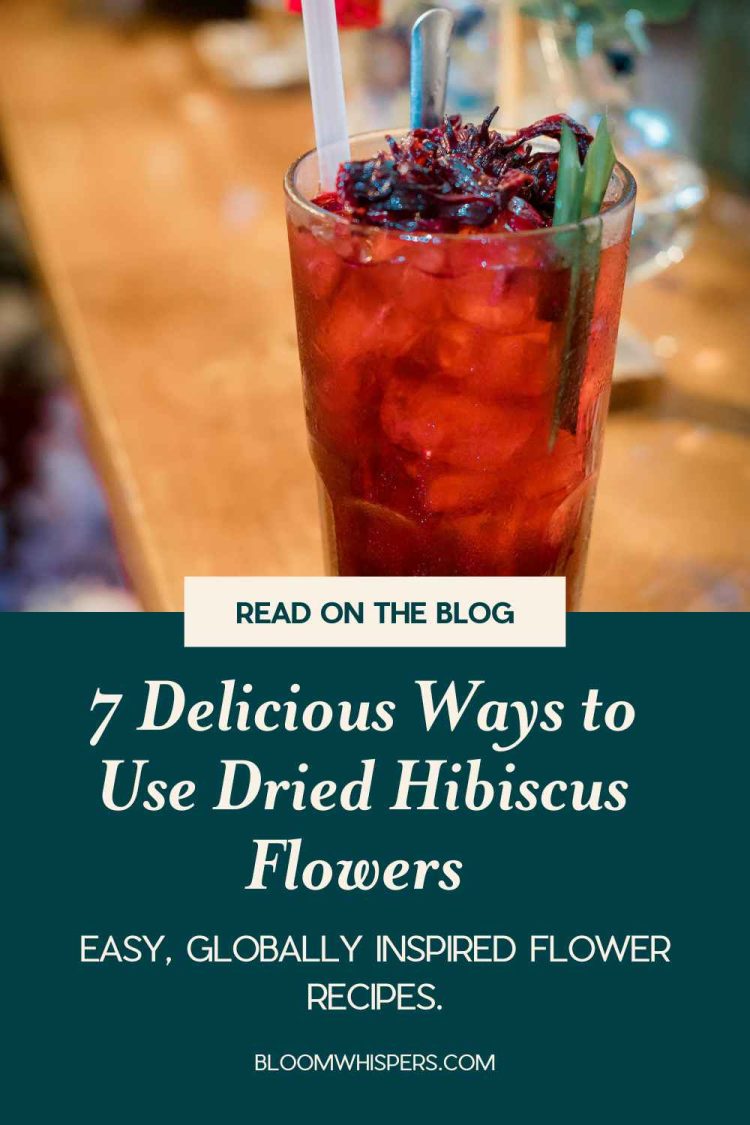Most people know hibiscus for its tart ruby tea. Agua de Jamaica in Mexico, Karkadeh in Egypt, Zobo in Nigeria.
But this flower, Hibiscus sabdariffa, has flavored and colored global cuisines for centuries.
Its deep-red calyces hold fruit acids, anthocyanins, and natural pectin, giving it tang, color, and structure that make it as versatile as citrus.
From jams to marinades, hibiscus transforms everyday recipes with both beauty and function.
Here are seven ways different cultures use dried hibiscus flowers, and how you can bring them into your own kitchen.
Flower Recipes: 7 Delicious Ways to Use Dried Hibiscus Flowers
1. Hibiscus Syrup for Drinks and Desserts
Origin: Mexico · France · North Africa
Across many cuisines, hibiscus syrup serves as both flavor and art.
In Mexico, it’s boiled with sugar and lime for Agua de Jamaica concentrado; in France and North Africa, it sweetens cocktails and patisserie glazes.
The result is a rich, jewel-toned syrup with a subtle cranberry flavor.
How to make it:
Simmer 1 cup dried hibiscus with 2 cups water and 1 cup sugar for 20 minutes.
Strain and refrigerate up to 10 days.
Uses: Drizzle over yogurt, fruit, pancakes, or blend into spritzers and sodas.
2. Hibiscus Flower Jam or Jelly
Origin: Caribbean · West Africa · French Creole Regions
Hibiscus jam — sometimes called sorrel jam — is a traditional preserve across the Caribbean and parts of West Africa.
The flower’s natural pectin makes it thicken beautifully without additives.
When cooked with apple, guava, or ginger, it develops a bright, tangy complexity.
How to make it:
Boil equal parts dried hibiscus and fruit (e.g., 1 cup each) with 1 ½ cups sugar and 1 lemon’s juice until it reaches a jammy consistency.
Uses: Spread on toast, serve with cheese, or spoon over pound cake.
3. Hibiscus Chamoy Sauce, with a Floral Twist
Origin: Mexico
Chamoy merges dried fruit, chiles, and hibiscus into one unforgettable condiment.
The flower adds natural acidity and color while softening the spice.
Traditionally used on fruit, it also doubles as a marinade.
How to make it:
Blend boiled hibiscus with dried apricots, lime juice, salt, sugar, and chili powder.
Uses: Dip mango and pineapple, glaze meats, or rim cocktail glasses.
4. Hibiscus Granita or Sorbet
Frozen hibiscus desserts appear wherever the weather demands refreshment.
In Italy, it’s granita; in Jamaica, frozen sorrel ice.
Hibiscus’s tartness pairs perfectly with citrus and herbs, making an aromatic and cooling treat.
How to make it:
Freeze hibiscus tea sweetened with sugar and lime, scraping it every hour to form ice crystals.
Uses: Serve as a palate cleanser or light summer dessert.
5. Hibiscus Vinaigrette or Salad Glaze
Origin: Modern fusion
Chefs use hibiscus concentrate as a natural acid in salad dressings.
Its subtle fruitiness balances oils beautifully, much like vinegar or lemon.
This practice echoes traditional African and Caribbean uses of hibiscus as a digestive aid.
How to make it:
Whisk hibiscus syrup with olive oil, honey, and Dijon mustard (2:3:1 ratio).
Uses: Over greens, roasted vegetables, or citrus salads.
6. Baked Goods with Hibiscus Sugar or Glaze
Origin: Global / Contemporary
Ground dried hibiscus gives sugar a pink hue and delicate tang.
Bakers use it to color frostings naturally or to dust cookies and pastries.
Its acidity subtly enhances chocolate, vanilla, and almond flavors.
How to make it:
Pulse dried hibiscus in a spice grinder and mix with granulated sugar (1 tbsp per ½ cup sugar).
Uses: Dust over shortbread, glaze donuts, or rim glassware for cocktails.
7. Hibiscus Marinade or Glaze for Savory Dishes
Origin: West Africa · Mexico
Beyond sweet applications, hibiscus is used as a natural tenderizer for meats.
In West African cuisine, its acids balance the richness of grilled meats and stews.
In modern Mexican cooking, hibiscus marinades bring depth to pork, fish, and tofu.
How to make it:
Combine brewed hibiscus tea with chili, garlic, and lime juice; marinate for 30 minutes before grilling.
Uses: Works beautifully with chicken, shrimp, or vegetables.
Hibiscus Flower: The Global Bloom That Keeps Adapting
Across continents, the hibiscus flower moves easily from ceremonial drink to culinary tool.
Its acids preserve, its color delights, and its symbolism endures: renewal through contrast — heat and cool, sweet and tart, tradition and reinvention.
Every time we use it, we’re repeating a practice older than recipes — one of color, care, and connection.
Discover Your Flower Ritual
If you love learning how flowers shape daily life, explore the Bloom Whispers Flower Ritual Quiz — a short reflection that reveals the bloom that matches your energy and rhythm.




📚 References
- Traditional and Modern Uses of Hibiscus Plants. Henry Bamidele (2025), Journal of Herbmed Pharmacology.
- Hibiscus — Natural Herbal Living Magazine (2022).
- Ethnomedicine, Phytochemistry, and Bioactivities of Hibiscus sabdariffa L. (JHP 2022).
- International Journal of Chemical and Biological Sciences (IJCBS), Khan et al. (2017).

